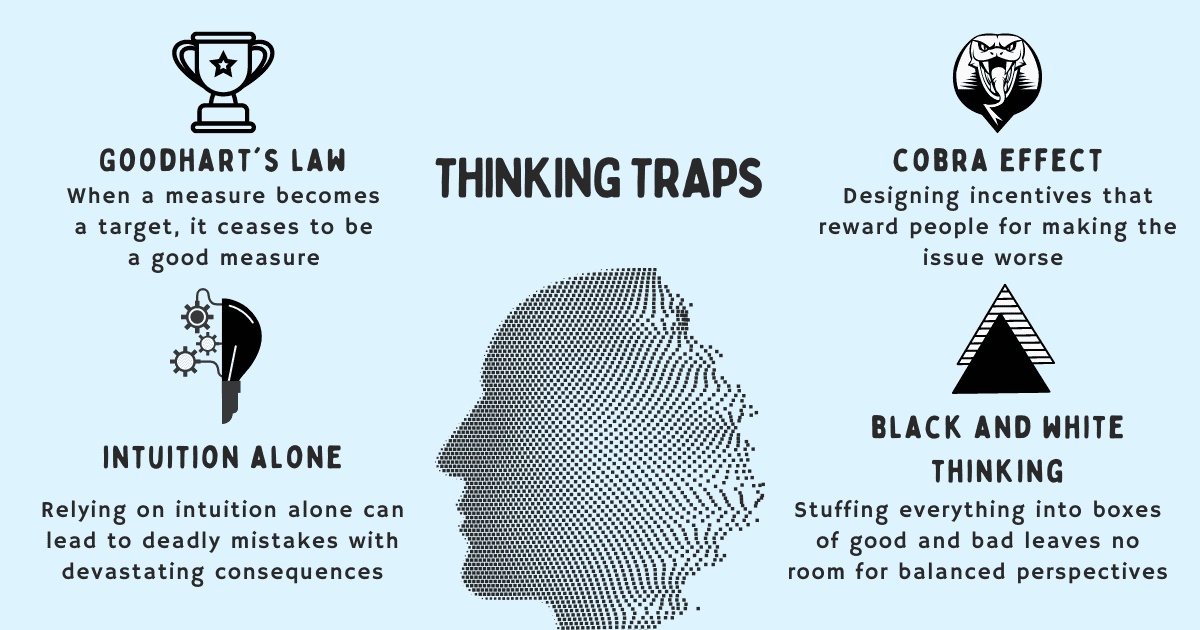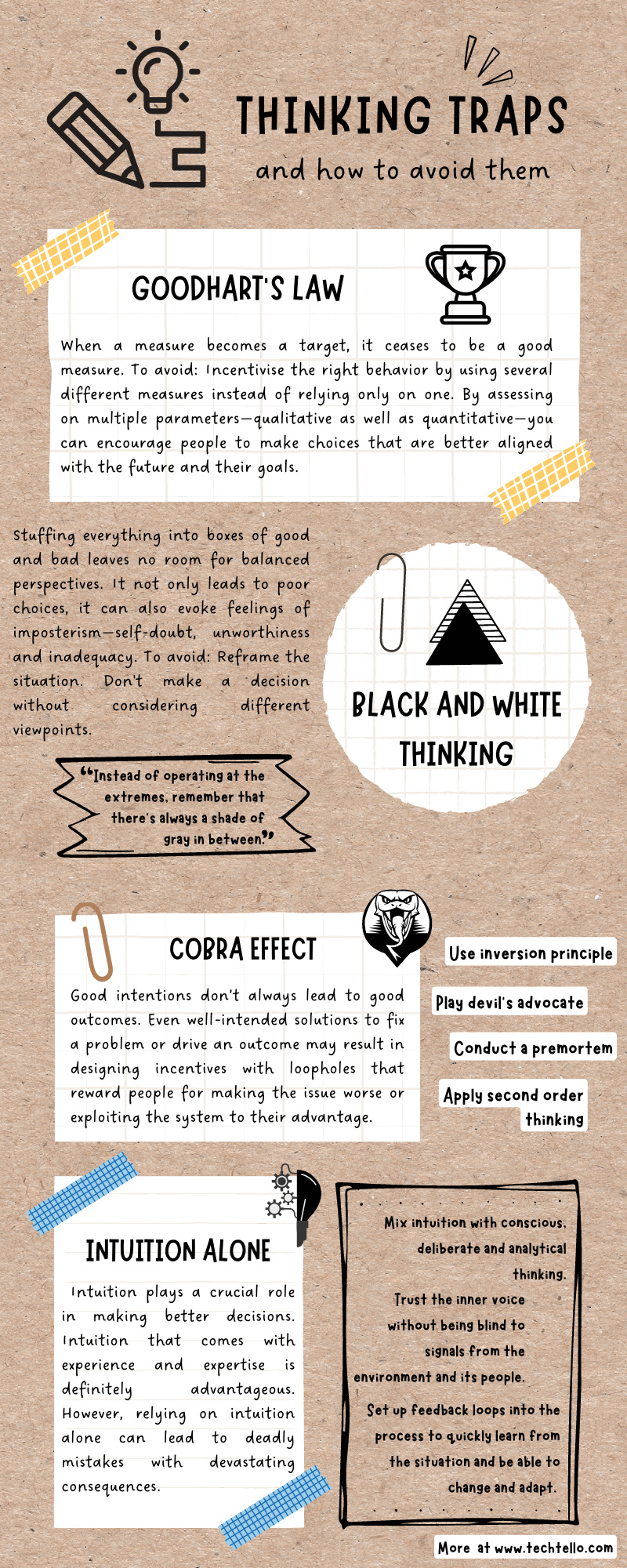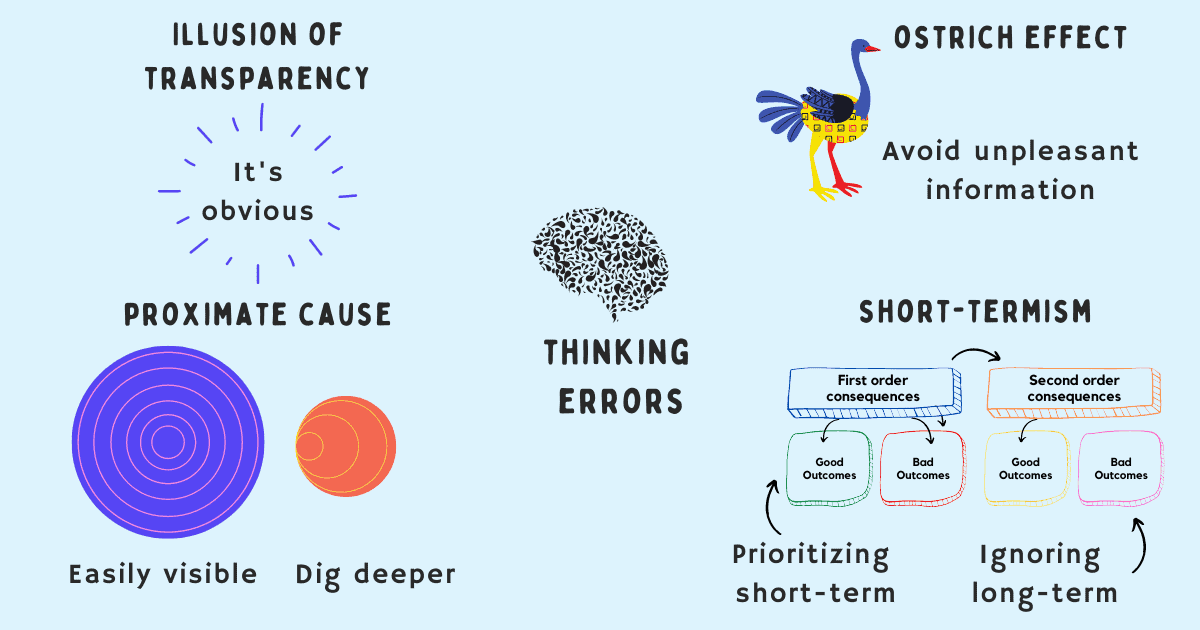Break Free From These 4 Leadership Thinking Traps

In the last article, I wrote about thinking errors that are the biggest cause of leadership ineffectiveness. When leaders don’t pay attention to how they think, make decisions and the impact it has on the organization and its people, their actions—however well intended they may be—cease to produce the desired effect.
Making good decisions isn’t just about making the right choices, it’s also about being able to recognize and eliminate bad ones.
Here are the other 4 thinking traps that add to leadership ineffectiveness:
- Goodhart’s law
- Black and white thinking
- Cobra effect
- Intuition alone
Goodhart’s law
Goodhart’s law states “When a measure becomes a target, it ceases to be a good measure.” In other words, when you start measuring people on specific end objectives, they will only optimize for that objective and try to achieve the outcome at all costs without considering the consequences.
When leaders design incentives focused on achieving set targets, it promotes unintended behavior—primary focus on goal achievement leads to maximizing measures on which people are judged without paying attention to the process that generated those results. It also leads to neglecting other important areas.
Incentive structures work. So you have to be very careful of what you incent people to do, because various incentive structures create all sorts of consequences that you can’t anticipate — Steve Jobs
How to avoid Goodhart’s law
A leader can make it difficult for employees to game the system and incentivise the right behavior by using several different measures instead of relying only on one. This great strategy is by John Doerr from Measure What Matters where he suggests pairing a quantity measure with a quality measure. For example, instead of considering only on-time deliveries as a measure of performance, include quality as a parameter too—how many bugs were reported, what did the code review process indicate, did it scale to future needs?
By assessing on multiple parameters—qualitative as well as quantitative—you encourage people to make choices that are better aligned with the future and their goals.
Example of Goodhart’s law
If an ad company is incentivised on CTR alone, they will optimize for clicks without paying attention to the target user. A high CTR in this case will achieve the goal even though the ad campaign will turn out to be ineffective.
To avoid the effect of Goodhart’s law, instead of measuring on CTR alone, include traffic quality as a measure too. This will ensure that the ad company optimizes the campaign to put the right ad in front of the right users.
Cognitive Distortions Bundle
Challenge and replace irrational thoughts with more realistic and adaptive thoughts.
Black and white thinking
When leaders think in terms of black and white—it’s right or wrong, good or bad, worthy or unworthy—they fail to consider all relevant facts and arguments before making a decision.
When the two words in their dictionary “always” and “never” rule their life, it is hard to separate fact from fiction. Preconceived notions combined with this rigidity in thinking is dangerous—it prevents them from learning, making corrections, and adapting to the needs of tomorrow.
Stuffing everything into boxes of good and bad leaves no room for balanced perspectives. It not only leads to poor choices, it can also evoke feelings of imposterism—self-doubt, unworthiness and inadequacy—in leaders.
Most people are binary and instant in their judgments; that is, they immediately categorize things as good or bad, true or false, black or white, friend or foe. A truly effective leader, however, needs to be able to see the shades of gray inherent in a situation in order to make wise decisions as to how to proceed — Steven Sample, The Contrarian’s Guide of Leadership
How to avoid black and white thinking
To stop thinking black and white and get closer to the objective truth:
- Instead of operating at the extremes, remember that there’s always a shade of gray in between. Words like “Maybe” and “sometimes” are better suited to describe most situations than “always” or “never.”
- Reframe the situation. Catch yourself jumping to conclusions and challenge yourself to think differently.
- In high stakes situations, don’t make a decision without considering different viewpoints. Force yourself to look at the situation from multiple angles and consider alternative explanations.
- Ask open ended questions instead of close ended questions. Open ended questions encourage inquiry while closed ended questions lead to black and white thinking.
- Get comfortable with cognitive dissonance—ability to hold two opposing thoughts without losing the ability to function.
Example of black and white thinking
Olivia thinks that people are either talented or they’re not. When one of her new report makes a mistake, she attributes the mistake to her incompetence. Black and white thinking makes her assume that her direct report is incapable of learning and no amount of effort can help her improve and do better.
These fixed mindset beliefs—certain people are born with special talents and others who are less talented cannot get better with determination and effort—makes her give less and less attention to her direct report. Without proper guidance, her direct report performs even worse which further reinforces her beliefs.
Olivia can avoid the effect of black and white thinking by looking for alternative ways to explain the mistake. She must also practice strategies to develop a growth mindset which will help her view intelligence as not fixed and something that can be increased with persistence, effort and hard work.
Cobra effect
Good intentions don’t always lead to good outcomes. Leaders well-intended solutions to fix a problem or drive an outcome may result in designing incentives with loopholes that reward people for making the issue worse or exploiting the system to their advantage.
When an attempted solution is not well thought out, it can lead to unintended consequences which can be detrimental to business in the long run.
Economist Horst Siebert termed this phenomenon as the cobra effect based on a time when India was ruled by the British government. Here’s how the story goes:
The British government was concerned about the number of venomous cobras in Delhi. To reduce the number of cobras, they decided to offer a bounty for every dead cobra.
The strategy worked beautifully in the beginning as a large number of cobras were killed for the reward. However, soon considering it as a good source of income, people began breeding cobras. The program was finally scrapped when the government realized their incentives were gamed. Without incentives, cobra breeders set the snakes free which further increased the cobra population in India.
How to avoid cobra effect
To avoid cobra effect:
- Apply the inversion principle. Instead of asking “how it might work?” ask “how it might go wrong?”
- Have an external party play the role of Devil’s advocate—someone who tries to find loopholes in the decision, why it might not work or how it can fail.
- Conduct a premortem—imagine your idea has failed terribly in the future. What aspects did you miss? What did you overlook?
- Apply second order thinking to consider the consequences of your decision not only on the present, but way into the future.
Example of cobra effect
Hacktoberfest is an October-long celebration to promote contributions to the free and open-source software communities. In 2020, participants were encouraged to submit four or more pull requests to any public free or open-source (FOS) repository, with a free “Hacktoberfest 2020” T-shirt for the first 75,000 participants to do so.
The free T-shirts caused thousands of frivolous pull requests on FOS projects. A large volume of pull requests made by users amounted to counterproductive changes to code, including: changing project names from “My Project” to “My Awesome Project”; changing bullet points to dashes; and in some cases, even breaking working code.
Intuition alone
A leader’s role involves encountering unknown situations, solving unseen problems and making tough decisions. In such cases, intuition plays a crucial role in making better decisions. Intuition that comes with experience and expertise is definitely advantageous—it enables them to see information that others might miss.
Economics Nobel laureate and author of Thinking, Fast and Slow, Daniel Kahneman defines intuition as “thinking that you know without knowing why you do.” He says that intuitive thinking has both advantages and disadvantages: it is faster than a rational approach but also more prone to error.
Relying on intuition alone can lead to deadly mistakes with devastating consequences. It can lead to significant errors in decision making.
- Since intuition relies on patterns from the past, it can make leaders pick a solution that worked well in the past even though the current situation is unique and demands a novel solution.
- Intuitive decision making can make leaders react to inaccurate, unreliable and incomplete information.
- Emotions help build and apply intuition, but they also give way to prejudices and biases. Not separating helpful from unhelpful emotions can get in the way of effective decision-making.
- Intuition also gives way to confirmation bias—making leaders reject hard evidence that might be screaming to be considered.
The decision maker of experience has at his disposal a checklist of things to watch out for before finally accepting a decision. A large part of the difference between the experienced decision maker and the novice in these situations is not any particular intangible like “judgment” or “intuition.” If one could open the lid, so to speak, and see what was in the head of the experienced decision-maker, one would find that he had at his disposal repertoires of possible actions; that he had checklists of things to think about before he acted; and that he had mechanisms in his mind to evoke these, and bring these to his conscious attention when the situations for decisions arose—Herbert Simon, Models of My Life
How to avoid intuition alone
To stop relying on intuition alone, leaders need to:
- Mix intuition with conscious, deliberate and analytical thinking. Master both intuition and analytical skills.
- Trust the inner voice without being blind to signals from the environment and its people.
- Consider the complexity of the decision and its scope—are too many parameters changing, what similarity does it have with your previous experience, how is it different from everything you have done so far?
- Set up feedback loops into the process to quickly learn from the situation and be able to change and adapt.
- Collect data, listen to inputs and delay intuitive thinking to the last.
Example of intuition alone
Jen is interviewing the marketing head for her new line of business today. The candidate’s resume stands out and so does the interview. She gave good answers, has the required experience and skills for the job and also appeared friendly and at ease during the interview.
Yet, Jen can’t seem to put off the feeling that something is off. She isn’t able to point out what exactly about the candidate bothers her, which further adds to her discomfort and anxiety.
Relying on her intuition alone and refusing to roll out the job offer in this case could be a mistake. Just because her intuition is telling her that it may not be right does not make it so. Jen should consider inputs from the interview and rationally evaluate the candidate on their skills and expertise required for the job and not base the decision purely on their gut.
Ignorance is a blank sheet on which we may write; but error is a scribbled one from which we must first erase.
— Charles Caleb Colton
Summary
- Effective leaders make good decisions by paying attention to their errors in thinking and taking steps to reduce them.
- Measuring employees on set targets encourages them to achieve the target without regard for their actions or the path they take to reach there. Also called Goodhart’s law, it incentivises undesirable and unintended behavior. Use both qualitative and quantitative inputs to reduce its effect.
- Black and white thinking makes leaders ignore crucial inputs. Shifting from extreme thinking to a solution in between enables better decision-making.
- Even with the best of intentions, some solutions may aggravate the problem instead of fixing the issue when leaders leave loopholes that incentivises people to misuse the system to their advantage. To avoid this, proactively identify what can cause your solution to not work or make it worse.
- Intuition could be a leader’s superpower when combined with a rational approach. Intuitive decision making alone cannot and should not be used.






























